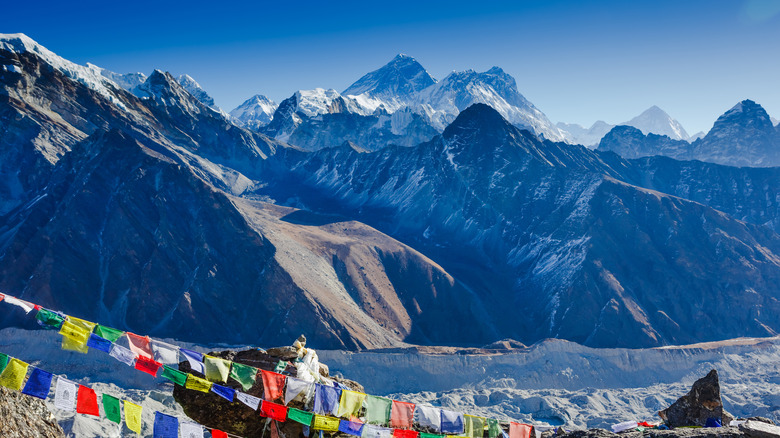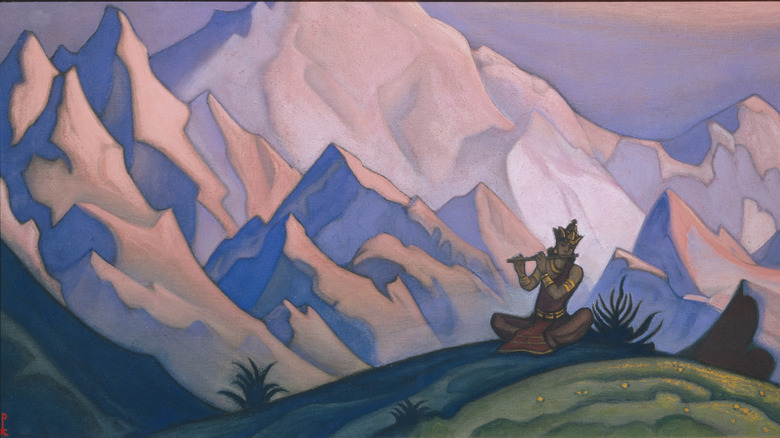The Legend Of Gyanganj: The Himalayas' Ancient City Of Immortals
Maybe you've heard of Shangri-La — a heaven on earth in the Himalayas. This mysterious mountain paradise is the fanciful product of English writer James Hilton's fertile imagination (via PBS), but while Hilton made up the name for his famous novel "Lost Horizon," he did not invent the legend itself — which has its roots in folklore common to the various countries that meet at the Himalayas' towering peaks (via Times of India).
This mythical mountain paradise has many names — it is typically called "Gyanganj" or "Siddhashrama" by Hindus in India, and "Shambala" by Buddhists in Tibet (via Tour My India). Its secret location, hidden deep in the mountains, is discussed in major texts from both major world religions.
The common thread in the various different versions of the story is that the residents of this hidden land have achieved some form of spiritual perfection, and as a result have quite sensibly shut themselves away from the world where the rest of us can't find them. You don't need to die to find this earthly heaven — and those who do find it will never die. Unfortunately, ordinary people will not be able to locate Gyanganj — because after all, only the spiritually advanced can attain immortality.
The Buddhist and Hindu versions
In the Hindu text, the "Ramayana," Siddhashrama (Gyanganj) is the site of a hermitage filled with ascetics — a place so holy it was once patronized by Lord Vishnu himself (via Valmiki Ramayana). Gyanganj also appears elsewhere in the "Vishnu Purana," which claims that the site is the location of Vishnu's birth as the avatar "Kalki" (via Study Buddhism), his birth here signals the end of an age of darkness and the beginning of an age of light.
Shambala is also discussed in detail in a Buddhist text, the "Kalachakra Tantra." Unlike our earthly rulers, the rulers of Shambala are wise and just, perfect followers of the Buddhist doctrine (via the BBC). Like the Hindu version, the Buddhist story has strong apocalyptic overtones. It is said that the kingdom of Shambala will be revealed when the world is in danger during a major crisis in our history. After the nations of the Earth fall under the heel of an evil tyrant, the armies of Shambala will emerge to save everyone, "... just when the world seems on the brink of total downfall and destruction, the mists will lift to reveal the icy mountains of Shambala." Many Buddhists do not take the story literally, instead seeing it as a metaphor for the progress of the soul in this life (via New World Encyclopedia).
Where is Gyanganj, if anywhere?
Many people have looked for Gyanganj but is there any basis for the story? On the one hand, it is easy to see how visitors to the Himalayas could come to characterize the region as a paradise — a place where sky-scraping mountains give climbers the chance to walk through the heavens — or at least clouds of water vapor. It is easy to be seduced by the landscape alone. Perhaps because of this, residents of Zongdian, in Yunnan province in China, decided to rename their town Shangri-La back in 2001(via National Geographic).
Incredulous readers will be unsurprised to discover that no satellite technology has ever found a magical land in India or Tibet — although countless people have looked (via Times of India). While true believers are likely to object that Shambala is not a physical place a person can find using GPS — but an alternate higher dimension (via PBS).
It is not unusual for mystics and religious figures to claim they've seen the real Gyanganj as a divine parallel world; the Hindu Guru Kaka Sai, for example, is just one well-known yogi believed to have reached the hidden plain via intense religious practice (via Saikaka). Spiritual seekers looking to find Gyanganj may have no choice but to turn inward, to find the mountain paradise.


